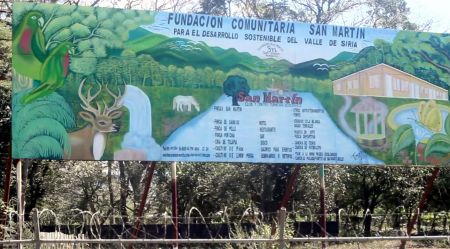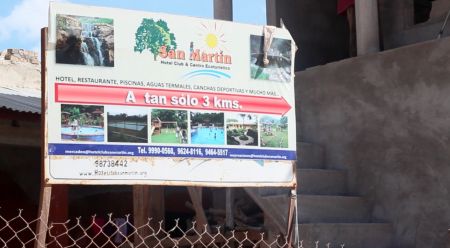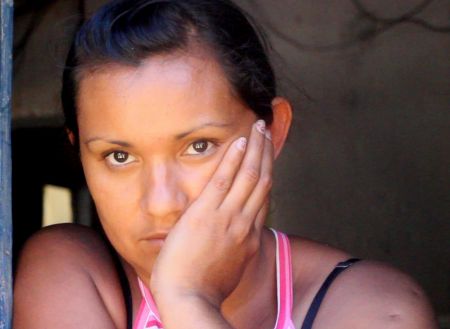EL PORVENIR—There are some things Goldcorp would probably rather forget about its San Martin mine in Honduras.
But Oneyda Velásquez can't forget. She lives three kilometres from the mine site in the Siria Valley, Honduras. She told The Dominion how both she and her children were tested and found to have heavy metals such as lead, mercury and arsenic in their blood. She said that since the opening of the mine, her family's health has gotten worse and the farming isn't the same either. “[My children] are constantly sick with the cold, headaches, and they have marks on their skin. [Goldcorp subsidiary] Entremares is the mine that's killing us,” said Velásquez.
The San Martin gold mine operated from 2000 to 2008, but local residents continue to feel its impacts. As production was winding down, Goldcorp, a Vancouver-based mining firm, claimed that the site would be converted into an ecological centre under the name of the San Martin Foundation—an attempt to re-brand the former mine as an ecotourism site. According to Goldcorp, the company has constructed an ecotourism hotel, a training centre for local communities and a sustainable business.
But the reality on the ground is a long way from the stories told in company documents and press releases.
A visit to the site in early 2013 revealed no evidence of a thriving hotel or ecotourism project. Instead, tall fences with barbed wire surrounded a space of land on the hill down from the mine. It cost $20 to enter the area and there were security forces guarding the site.
Goldcorp created a promotional video for the site that is featured on their company website. “Chickens, pigs and cattle are farmed on the 1,500 hectare former mine site, providing functioning ecosystems, sustainable jobs and skills training to the people of the Valle de Siria,” the company claims.
Locals say they've watched the video, and that the people in it—who wave at the camera, play soccer and work in the hotel—are not from around there.
The International Ecotourism Society (TIES), the foremost international body that registers ecotourism projects defines ecotourism as "responsible travel to natural areas that conserves the environment and improves the well-being of local people."
The San Martin Foundation is not registered with TIES. When told about the foundation, TIES communications director Ayako Ezaki said that while an assessment by TIES has not been made, if the details presented were true, then “utilizing the term 'ecotourism' to describe the centre would be a clear case of green-washing and irresponsible and misleading marketing.”
Residents claim that Goldcorp's San Martin Foundation should not fall under the definition of ecotourism. Members of the Siria Valley Environmental Committee fear that the site is acting as a placeholder for the mine to re-open in the future once new mining regulations come into place.
From the time of its arrival in the Siria Valley, Goldcorp framed mining as development. In its global operations, the company has collaborated with NGOs funded by the Canadian International Development Agency (CIDA), particularly the World Wildlife Fund (WWF) and CARE. Goldcorp boasts of these collaborations in its Corporate Social Responsibility (CSR) reports, but no such projects have been undertaken locally in the Siria Valley.
Goldcorp claims to work with and fund CARE to “refine and expand the sustainable community investment guidelines, and optimize new opportunities to benefit local communities and national economies.” CARE receives CIDA funding for its work in Honduras and elsewhere; CARE received $5 million from CIDA for its water and sanitation projects in Honduras between 2006 and 2012, as well as close to $53,000 for general operations in Honduras, and another $13 million for further projects for 2010 to 2017.
According to the Siria Valley Environmental Committee, CARE representatives explored the possibility of working in the Siria Valley and met with several local officials. However, there was significant community opposition to CARE’s presence because of its affiliation with Goldcorp, and no project was ever realized.
WWF and Goldcorp have also collaborated on projects, including exchanges such as a $50,000 donation by Goldcorp to WWF for research into North American economic dependence on water resources and the provision of a company expert for a WWF study examining gold mining and its water footprint. CIDA has also funded WWF. An ongoing $15 million CIDA project in Mozambique, for example, included a $74,000 contribution to WWF for civil society participation in a CSR debate. The same CIDA project provided technical assistance to the Mozambican Ministry of Mineral Resources (MIREM) for policy development regarding the mining and oil and gas industries.
Back in Honduras, Siria Valley residents say that before the mine opened, company representatives held parties, gave out gifts and offered notebooks and piñatas to the children. The controversial consultation process was followed by the opening of the mine, which went ahead despite widespread dissent.
Pedro Landa, the human rights and environment program coordinator with the Honduran Centre for the Promotion of Community Development (CEHPRODEC), called the marriage between mining and development agencies a strategy of war.
“First you do a project about water, talk about sustainability and development, promise to help the children,” Landa told The Dominion in an interview in Tegucigalpa in February 2013. “Then, they will say that Goldcorp is a good neighbour and try to tell people that the mine will be good for their community.”
The work of NGOs in collaboration with mining companies can have a coercive effect on prospective or established mining communities since certain projects appear to, and may actually be connected to the presence of the mine, according to Jamie Kneen, communications and outreach coordinator at MiningWatch Canada. NGOs end up covering costs that would otherwise have to be covered by the company and in many cases, at least part of their funding comes from Canadian public funding, through CIDA. This marks a shift from the way things were done in the past, said Kneen.
“Individual NGOs have been involved with mining companies for decades, but not with CIDA funding these activities,” he told The Dominion. “Until last year, CIDA was not allowed to fund private companies, only civil society organizations,” noting that a previous specific CIDA program for commercial support, CIDA Industrial Cooperation Program (CIDA-INC), ran from 1978 to 2005 and failed.
CIDA now openly emphasizes the private sector and particularly mining; the agency has started providing direct funding for specific projects that directly involve mining companies. “While mining companies may also contribute funds, the projects are mostly funded by CIDA through public funds,” said Kneen.
In turn, he explained that most NGOs have traditionally stayed at arms-length from government and industry, and were able to work with communities affected by mining in providing support and analysis for environmental and health struggles. Now NGOs feel pressured to work with mining companies or lose funding, and some NGOs that are critical of mining have recently lost CIDA funding for their stance on mining, said Kneen.
In Honduras, CIDA has also worked on mining policy and helped shape the new Honduran mining law. Ratified by the National Congress in February 2013, the law has been critiqued by widespread local organizations as being overly protective of mining companies and too pro-mining.
In a report published in June 2012, Jennifer Moore, MiningWatch Canada’s Latin America program coordinator, wrote that Canada's involvement in the new mining law raises “questions about Canada’s conflict of interest in advising another country on its mining law and exposes the Canadian government’s policy for the overseas extractive sector as one of convenience—not responsibility.”
Fabricio Sandoval is an activist, writer and a young member of the LIBRE political party, which was formed in 2011 by a broad coalition of organizations opposed to the coup d'etat. He told The Dominion that development has become a hot topic in the lead-up to the November 2013 elections in Honduras.
“When foreigners and mining companies speak of wanting to bring development, what they are bringing is capitalist development,” said Sandoval, adding that job creation is minimal and supplies are often imported. “The word 'development' is a front.”
Tatiana Lara, a Honduran economist who specializes in non-profit organization and finance, spoke with The Dominion regarding foreign NGOs in Honduras. “One problem with development is that foreigners who donate to NGOs such as CARE do not understand the complexity and power structures at local levels. They think that painting a school or giving a scholarship to children is development,” she said. “This is not what people want or need. It simplifies reality and the way that NGOs and foreign governments like Canada are involved and interfering in local power structures.”
Rachel Deutsch has worked in human rights, the arts and social work with communities. Recently, her work has focused on contamination from Canadian industries both in Canada and in Latin America.






